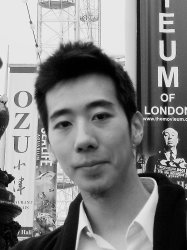Summary
Dr. Huai-Ti Lin joined the department in 2017 as a Lecturer (US equivalent: Assistant Professor). Dr. Lin is fascinated by how animals move and how they guide their movements. This interest has led him to study locomotion, neurobiology, bio-inspired robotics, and animal flight. Specifically, he is interested in how neural information is coupled to the physical bodies to produce highly sophisticated biological motor control and intelligent behaviors. Dr. Lin chose to work with insects both in the lab and in the field because their diversity provides many special abilities in sensing and motor control which current engineered systems are struggling to achieve. Dr. Lin believes in translating biological first principles to engineering ideas.
A large proportion of biological motion control can be attributed to vision, mechanosensation, or the combination of the two. Dr. Lin’s lab studies both sensory modalities in insects under the context of complex motion control. Dr. Lin co-developed the insect-scale motion capture and ultra-light wireless neural recording techniques. This combination of technologies allows him to study neural signaling in large freely behaving/flying insects, such as the dragonfly. The details of insect sensor architecture, signal encoding, biomechanical coupling and the associated behavioral strategies will become the basis for the development of bio-inspired sensors, neural devices, control algorithms, mechanical designs and robots in his lab.
For more details, please go to the lab website (htlinlab.com).
Prior to joining the department, Dr. Lin received his first degree in physics and biology at University of Massachusettes Amherst. Then he obtained his PhD from Tufts University in the areas of biomechanics and bio-inspired robotics. Dr. Lin devoted many years in postdoctoral training in animal flight research at Harvard University and systems neuroscience at Howard Hughes Medical Institute Janelia Research Campus.
Publications
Journals
Lin H-T, Leonardo A, 2017, Heuristic Rules Underlying Dragonfly Prey Selection and Interception, Current Biology, Vol:27, ISSN:0960-9822, Pages:1124-1137
Ros IG, Bhagavatula PS, Lin H-T, et al., 2017, Rules to fly by: pigeons navigating horizontal obstacles limit steering by selecting gaps most aligned to their flight direction, Interface Focus, Vol:7, ISSN:2042-8898, Pages:20160093-20160093
Bomphrey RJ, Nakata T, Henningsson P, et al., 2016, Flight of the dragonflies and damselflies, Philosophical Transactions of the Royal Society B: Biological Sciences, Vol:371, ISSN:0962-8436, Pages:20150389-20150389
Conference
Fabian JM, Maeda M, Siwanowicz I, et al., 2019, Toward the Neural Representation of Aeroelasticity in Insect Wings, Annual Meeting of the Society-for-Integrative-and-Comparative-Biology (SICB), OXFORD UNIV PRESS INC, Pages:E310-E310, ISSN:1540-7063
Ko DD, Lin H-T, 2019, The Role of Head Roll during Dragonfly Visual Guidance, Annual Meeting of the Society-for-Integrative-and-Comparative-Biology (SICB), OXFORD UNIV PRESS INC, Pages:E350-E350, ISSN:1540-7063

